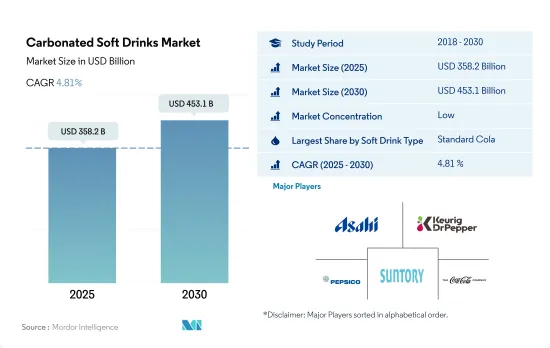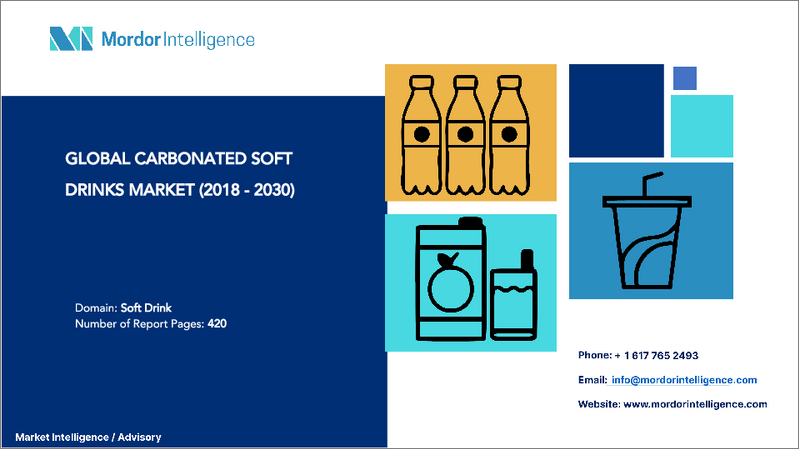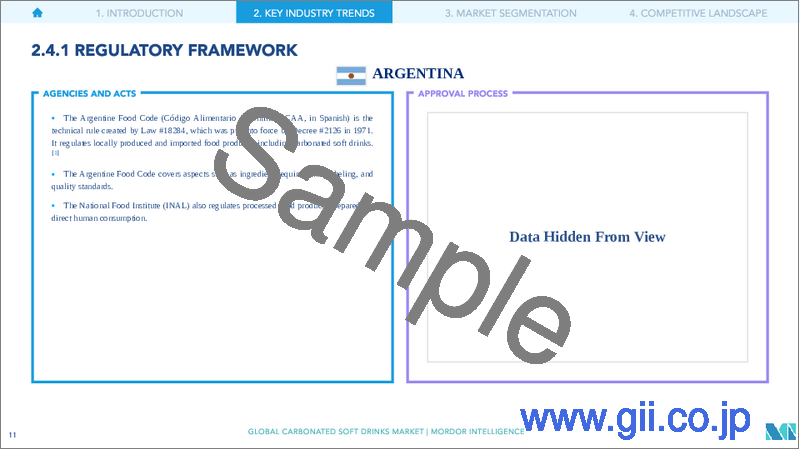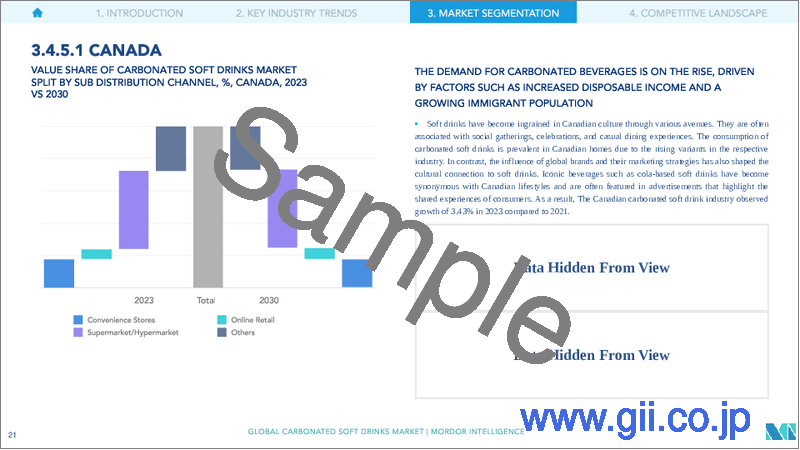|
|
市場調査レポート
商品コード
1685688
炭酸飲料:市場シェア分析、産業動向・統計、成長予測(2025年~2030年)Carbonated Soft Drinks - Market Share Analysis, Industry Trends & Statistics, Growth Forecasts (2025 - 2030) |
||||||
カスタマイズ可能
適宜更新あり
|
|||||||
| 炭酸飲料:市場シェア分析、産業動向・統計、成長予測(2025年~2030年) |
|
出版日: 2025年03月18日
発行: Mordor Intelligence
ページ情報: 英文 391 Pages
納期: 2~3営業日
|
全表示
- 概要
- 目次
炭酸飲料市場規模は2025年に3,582億米ドルと推定され、2030年には4,531億米ドルに達すると予測され、予測期間中(2025~2030年)のCAGRは4.81%で成長する見込みです。

低カロリー飲料やゼロカロリー飲料など製品の多様化が市場の成長を牽引
- スタンダードコーラが世界の炭酸飲料市場を席巻し、他のバリエーションを上回る。2018年から2023年にかけて、スタンダードコーラ市場は金額ベースで3.33%の堅調なCAGRを記録しました。この成長は、主にコカ・コーラやペプシのような有名ブランドが牽引する、これらの飲料に対する消費者の強い需要に起因しています。これらの業界大手は、一貫してマーケティングと広告に多額のリソースを割り当て、市場での存在感を高めています。
- ダイエット・コーラの需要は、世界の消費の高まりに後押しされて急速に増加しています。消費者が低糖質の選択肢を選ぶ傾向が強まる中、炭酸飲料(CSD)メーカーはポートフォリオの多様化を進めています。低カロリーやゼロカロリーの商品、さまざまなフレーバーを発売し、この増加傾向を取り込もうとしています。2023年2月、ペプシコはノンカフェインのレモンライム・ソーダ(Starry Lemon &Lime)を、レギュラーと糖分ゼロの両方で発表しました。同社は、米国の小売店や外食店で広く販売されることを発表しました。同様に、ペプシは2023年1月、甘味料システムを刷新し、より爽快な風味を実現した「ペプシ・ゼロシュガー」を発売しました。
- フルーツ風味の炭酸飲料は、2024~2030年のCAGRが金額ベースで4.94%と最も高くなる見通しです。これらの炭酸飲料は、天然甘味料と低カロリーまたはカロリーゼロの配合で作られることが多く、消費者の健康志向の高まりに合致しています。天然素材への嗜好の高まりと多様な味覚オプションへの欲求は、今後数年間、こうしたフルーツ風味の天然甘味料入りソーダの需要を促進すると予想されます。
炭酸飲料は世界的に、消費者の嗜好に共鳴する健康属性や成分を取り入れる傾向が強まっています。
- 2019年から2023年にかけて、世界の炭酸飲料市場は金額ベースで14.68%の堅調な成長を遂げました。この急成長の主な要因は、より健康的な食品オプションに対する消費者の志向の高まりと、メーカーによる意図的な成分選択の転換です。その結果、無糖、オーガニック、ダイエット・コーラなどの製品が登場し、より健康的な代替品として人気を集めました。特筆すべきは、多様なフレーバーと特定のブランドが健康上のメリットを連想させることが、このセグメントの成長をさらに後押ししていることです。2023年には、著名ブランドのBisleriが、Rev、Pop、Spyci Jeeraのサブブランドで、発泡性コーラ、オレンジ、ジーラのフレーバーにまたがる4つの新バリエーションを発売しました。同様に2022年には、PepsiCo.が従来のソフトドリンクよりもマイルドな味わいの窒素入りコーラ、Nitro Pepsiを発表しました。
- 調査期間を通じて、北米が市場の大部分を占めており、この優位性は今後も続くと予測され、2023年から2027年までの成長率は13.40%と予想されます。この地域の炭酸飲料への親しみは、伝統的な消費パターンに深く根ざしており、しばしば食事と一緒に飲まれています。特に、マクドナルドやドミノ・ピザのような大手ファストフード・チェーンは、手頃な食事プランにソフトドリンクの注文を組み込んでおり、この嗜好をさらに強固なものにしています。
- アフリカは炭酸飲料の急成長市場になる見通しで、予測CAGRは8.12%です。同地域の消費者は、味の嗜好が重要な役割を果たしながら、さまざまなブランドから提供される豊富な種類のソフトドリンクに惹かれています。特にこの地域では、砂糖とカフェインの含有量が少ない製品が好まれます。
世界の炭酸飲料市場動向
世界の炭酸飲料は、消費者の嗜好に合う健康特性や成分をますます取り入れるようになっています。
- 炭酸飲料の消費頻度は、味の好み、利便性、文化的規範、健康への配慮、人口統計学的要因など複数の要因に影響されます。ソフトドリンクの消費量が最も多いのは南北アメリカで、次いで欧州、アジア太平洋の順です。南北アメリカでは、平均して年間152リットルのソフトドリンクを消費しています。欧州では年間91リットル、アジア太平洋では年間62リットルです。
- クリーンラベル、グルテンフリー、低カロリー、低炭水化物製品に対する需要の高まりが、低カロリー炭酸飲料市場の成長につながりました。機能性飲料市場全体の成長と消費者の健康意識の高まりが、低カロリー炭酸飲料の成長を後押ししています。パッケージも消費者の認知に影響を与える重要な製品属性です。炭酸飲料のパッケージのデザイン、サイズ、機能性は、人目を引くラベルや鮮やかな色で購買決定に影響を与えています。
- 価格感応度は、炭酸飲料市場に影響を与える重要なパラメーターです。消費者の間で価格感応度が比較的低く、手頃な嗜好品とみなされることが多いからです。急速な都市化も、世界の市場成長の重要な要因です。2022年の世界の都市化率は57%でした。国内の大都市圏に住む人口は増加の一途をたどり、炭酸飲料の伸びを支えています。
- 砂糖の大量摂取や消費による糖尿病や肥満の健康への影響から、低カロリーで砂糖不使用の代替品への需要が世界的に高まっています。世界の成人の約13%が肥満であり、成人の39%が過体重です。現在の市場シナリオを形成しているもう一つの要因は、砂糖消費削減を目的とした規制措置の実施です。各地域の政府は、砂糖入り飲料への課税を導入し、それに応じた表示要件を実施しています。
炭酸飲料産業の概要
炭酸飲料市場は細分化されており、上位5社で19.94%を占めています。この市場の主要企業は以下の通りです。 Asahi Group Holdings, Ltd., Keurig Dr Pepper, Inc., PepsiCo, Inc., Suntory Holdings Limited and The Coca-Cola Company(sorted alphabetically).
その他の特典
- エクセル形式の市場予測(ME)シート
- 3ヶ月のアナリストサポート
目次
第1章 エグゼクティブサマリーと主な調査結果
第2章 レポートのオファー
第3章 イントロダクション
- 調査の前提条件と市場定義
- 調査範囲
- 調査手法
第4章 主要産業動向
- 消費者の購買行動
- イノベーション
- ブランドシェア分析
- 規制の枠組み
第5章 市場セグメンテーション
- ソフトドリンクタイプ
- ダイエットコーラ
- フルーツフレーバー炭酸飲料
- スタンダードコーラ
- その他のタイプ
- 包装タイプ
- 使い捨てカップ
- ガラス瓶
- 金属缶
- ペットボトル
- 流通チャネル
- オフトレード
- コンビニエンスストア
- オンライン小売
- スーパーマーケット/ハイパーマーケット
- その他
- オン・トレード
- オフトレード
- 地域
- アフリカ
- エジプト
- ナイジェリア
- 南アフリカ
- その他のアフリカ
- アジア太平洋
- オーストラリア
- 中国
- インド
- インドネシア
- 日本
- マレーシア
- 韓国
- タイ
- ベトナム
- その他アジア太平洋地域
- 欧州
- ベルギー
- フランス
- ドイツ
- イタリア
- オランダ
- ロシア
- スペイン
- トルコ
- 英国
- その他欧州
- 中東
- カタール
- サウジアラビア
- アラブ首長国連邦
- その他中東
- 北米
- カナダ
- メキシコ
- 米国
- その他北米地域
- 南米
- アルゼンチン
- ブラジル
- その他南米
- アフリカ
第6章 競合情勢
- 主要な戦略動向
- 市場シェア分析
- 企業情勢
- 企業プロファイル
- Asahi Group Holdings, Ltd.
- Britvic PLC
- Hangzhou Wahaha Group Co., Ltd.
- Keurig Dr Pepper, Inc.
- Kirin Holdings Company, Limited
- National Beverage Corp.
- Nongfu Spring Co., Ltd.
- PepsiCo, Inc.
- PT. Anggada Putra Rekso Mulia
- Rauch Fruchtsafte GmbH & Co OG
- Refresco Group BV
- Suntory Holdings Limited
- Thai Beverages PCL
- The Coca-Cola Company
- Tingyi(Cayman Islands)Holding Corporation
第7章 CEOへの主な戦略的質問
第8章 付録
- 世界概要
- 概要
- ファイブフォース分析フレームワーク
- 市場力学(DROs)
- 情報源と参考文献
- 図表一覧
- 主要洞察
- データパック
- 用語集
The Carbonated Soft Drinks Market size is estimated at 358.2 billion USD in 2025, and is expected to reach 453.1 billion USD by 2030, growing at a CAGR of 4.81% during the forecast period (2025-2030).

Diversification of product launches, such as low and zero-calorie drinks, is driving the market growth
- Standard cola dominated the global carbonated beverage market, surpassing other variants. From 2018 to 2023, the standard cola market witnessed a robust CAGR of 3.33% by value. This growth can be attributed to the strong consumer demand for these beverages, primarily driven by renowned brands like Coca-Cola and Pepsi. These industry giants consistently allocate substantial resources to marketing and advertising, bolstering their market presence.
- The demand for diet cola is rapidly increasing, fueled by rising consumption worldwide. As consumers increasingly opt for lower-sugar options, carbonated soft drink (CSD) manufacturers are diversifying their portfolios. They are introducing low- and zero-calorie variants, along with a range of flavors, to tap into this growing trend. In February 2023, PepsiCo unveiled a caffeine-free lemon-lime soda, branded Starry Lemon & Lime, in both regular and zero-sugar versions. The company announced its wide availability across US retailers and food service outlets. Similarly, in January 2023, Pepsi introduced an enhanced iteration of its Pepsi Zero Sugar, featuring a revamped sweetener system for a more invigorating flavor profile.
- Fruit-flavored carbonated beverages are poised to witness the highest CAGR of 4.94% by value during 2024-2030. These sodas, often crafted with natural sweeteners and low or no-calorie formulations, align with consumers' growing health consciousness. The rising preference for natural ingredients and a desire for diverse taste options are expected to fuel the demand for these fruit-flavored, natural sweetener-infused sodas in the coming years.
Carbonated soft drinks, globally, are increasingly incorporating health attributes and ingredients that resonate with consumer preferences
- From 2019 to 2023, the global carbonated soft drinks market witnessed a robust 14.68% growth in value. This surge was primarily fueled by a rising consumer inclination toward healthier food options and a deliberate shift in ingredient choices by manufacturers. Consequently, the market saw the emergence of products like sugar-free, organic, and diet colas, gaining popularity as healthier alternatives. Notably, a diverse range of flavors and the association of certain brands with health benefits further bolstered this segment's growth. In 2023, Bisleri, a prominent brand, introduced four new variants, spanning fizzy cola, orange, and jeera flavors, under its sub-brands Rev, Pop, and Spyci Jeera. Similarly, in 2022, PepsiCo. unveiled Nitro Pepsi, a nitrogen-infused cola with a milder taste than traditional soft drinks.
- Throughout the study period, North America held the lion's share of the market, and this dominance is projected to continue, with an expected growth rate of 13.40% from 2023 to 2027. The region's affinity for carbonated soft drinks is deeply rooted in its traditional consumption patterns, often paired with meals. Notably, major fast-food chains like McDonald's and Domino's Pizza have ingrained soft drink orders into their affordable meal plans, further solidifying this preference.
- Africa is poised to be the fastest-growing market for carbonated soft drinks, with a projected value CAGR of 8.12%. The region's consumers are drawn to the wide array of soft drink offerings from various brands, with taste preferences playing a pivotal role. Notably, products with lower sugar and caffeine content are particularly favored in this region.
Global Carbonated Soft Drinks Market Trends
Carbonated soft drinks, globally, are increasingly incorporating health attributes and ingredients that resonate with consumer preferences
- The frequency of consumption of carbonated soft drinks is influenced by multiple factors such as taste preferences, convenience, cultural norms, health considerations and demographic factors. The highest consumption of soft drinks is in the Americas, followed by Europe and Asia Pacific. In the Americas, the average person consumes 152 liters of soft drinks per year. In Europe, the average is 91 liters per year, and in Asia Pacific, it is 62 liters per year.
- The growing demand for clean-label, gluten-free, low-calorie, and low-carb products led to the growth of the low-calorie carbonated beverages market. The growth in the overall functional beverage market and increasing health consciousness among consumers have fuelled the growth of low-calorie carbonated soft drinks. Packaging is another key product attribute that affects consumer perception. The design, size and functionality of soda packaginhg is influencing purchasing decisions with eye-catching labels and vibrant colors.
- Price sensititivy is an important parameter that influences the carbonated soft drinks market as they are often considered affordable indulgences with relatively low price sensitivity among consumers. Rapid urbanization is another key factor behind the significant market growth globally. The global urbanization rate was 57% in 2022. The population living in large urban areas in the country has increased constantly supporting the gorwth of carbonated soft drinks.
- Higher demand for low calories and sugar free alternatives has risen among consumers globally due to health effects of high sugar intake and consumption diabetes and obesity. Around 13% of adults in the world are obese, and 39% of adults are overweight. Another factor shaping the current market scenario is the implemenation of regulatory measures aimed at reducing sugar consumption. Governments across regions are introducing taxes on sugary beverages and implementing labelling requirements accordingly.
Carbonated Soft Drinks Industry Overview
The Carbonated Soft Drinks Market is fragmented, with the top five companies occupying 19.94%. The major players in this market are Asahi Group Holdings, Ltd., Keurig Dr Pepper, Inc., PepsiCo, Inc., Suntory Holdings Limited and The Coca-Cola Company (sorted alphabetically).
Additional Benefits:
- The market estimate (ME) sheet in Excel format
- 3 months of analyst support
TABLE OF CONTENTS
1 EXECUTIVE SUMMARY & KEY FINDINGS
2 REPORT OFFERS
3 INTRODUCTION
- 3.1 Study Assumptions & Market Definition
- 3.2 Scope of the Study
- 3.3 Research Methodology
4 KEY INDUSTRY TRENDS
- 4.1 Consumer Buying Behaviour
- 4.2 Innovations
- 4.3 Brand Share Analysis
- 4.4 Regulatory Framework
5 MARKET SEGMENTATION (includes market size in Value in USD and Volume, Forecasts up to 2030 and analysis of growth prospects)
- 5.1 Soft Drink Type
- 5.1.1 Diet Cola
- 5.1.2 Fruit Flavored Carbonates
- 5.1.3 Standard Cola
- 5.1.4 Other Types
- 5.2 Packaging Type
- 5.2.1 Disposable Cups
- 5.2.2 Glass Bottles
- 5.2.3 Metal Can
- 5.2.4 PET Bottles
- 5.3 Distribution Channel
- 5.3.1 Off-trade
- 5.3.1.1 Convenience Stores
- 5.3.1.2 Online Retail
- 5.3.1.3 Supermarket/Hypermarket
- 5.3.1.4 Others
- 5.3.2 On-trade
- 5.3.1 Off-trade
- 5.4 Region
- 5.4.1 Africa
- 5.4.1.1 Egypt
- 5.4.1.2 Nigeria
- 5.4.1.3 South Africa
- 5.4.1.4 Rest of Africa
- 5.4.2 Asia-Pacific
- 5.4.2.1 Australia
- 5.4.2.2 China
- 5.4.2.3 India
- 5.4.2.4 Indonesia
- 5.4.2.5 Japan
- 5.4.2.6 Malaysia
- 5.4.2.7 South Korea
- 5.4.2.8 Thailand
- 5.4.2.9 Vietnam
- 5.4.2.10 Rest of Asia-Pacific
- 5.4.3 Europe
- 5.4.3.1 Belgium
- 5.4.3.2 France
- 5.4.3.3 Germany
- 5.4.3.4 Italy
- 5.4.3.5 Netherlands
- 5.4.3.6 Russia
- 5.4.3.7 Spain
- 5.4.3.8 Turkey
- 5.4.3.9 United Kingdom
- 5.4.3.10 Rest of Europe
- 5.4.4 Middle East
- 5.4.4.1 Qatar
- 5.4.4.2 Saudi Arabia
- 5.4.4.3 United Arab Emirates
- 5.4.4.4 Rest of Middle East
- 5.4.5 North America
- 5.4.5.1 Canada
- 5.4.5.2 Mexico
- 5.4.5.3 United States
- 5.4.5.4 Rest of North America
- 5.4.6 South America
- 5.4.6.1 Argentina
- 5.4.6.2 Brazil
- 5.4.6.3 Rest of South America
- 5.4.1 Africa
6 COMPETITIVE LANDSCAPE
- 6.1 Key Strategic Moves
- 6.2 Market Share Analysis
- 6.3 Company Landscape
- 6.4 Company Profiles
- 6.4.1 Asahi Group Holdings, Ltd.
- 6.4.2 Britvic PLC
- 6.4.3 Hangzhou Wahaha Group Co., Ltd.
- 6.4.4 Keurig Dr Pepper, Inc.
- 6.4.5 Kirin Holdings Company, Limited
- 6.4.6 National Beverage Corp.
- 6.4.7 Nongfu Spring Co., Ltd.
- 6.4.8 PepsiCo, Inc.
- 6.4.9 PT. Anggada Putra Rekso Mulia
- 6.4.10 Rauch Fruchtsafte GmbH & Co OG
- 6.4.11 Refresco Group BV
- 6.4.12 Suntory Holdings Limited
- 6.4.13 Thai Beverages PCL
- 6.4.14 The Coca-Cola Company
- 6.4.15 Tingyi (Cayman Islands) Holding Corporation
7 KEY STRATEGIC QUESTIONS FOR SOFT DRINK CEOS
8 APPENDIX
- 8.1 Global Overview
- 8.1.1 Overview
- 8.1.2 Porter's Five Forces Framework
- 8.1.3 Market Dynamics (DROs)
- 8.2 Sources & References
- 8.3 List of Tables & Figures
- 8.4 Primary Insights
- 8.5 Data Pack
- 8.6 Glossary of Terms





